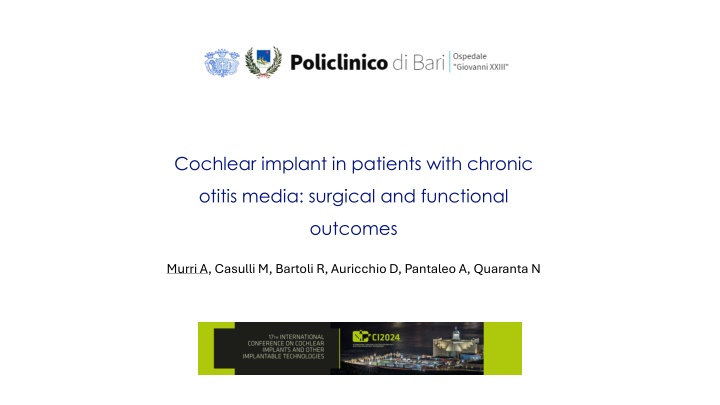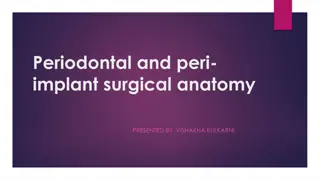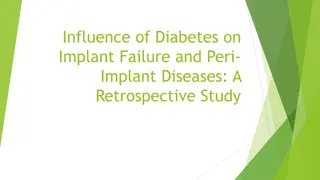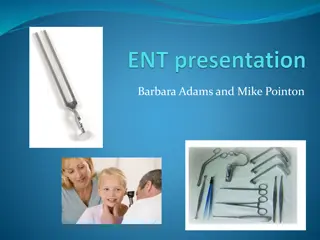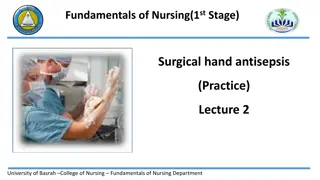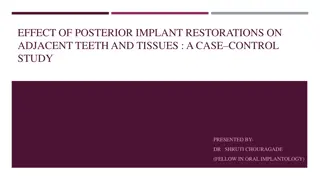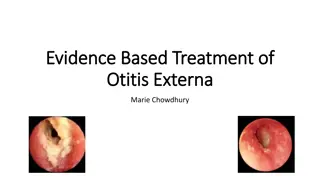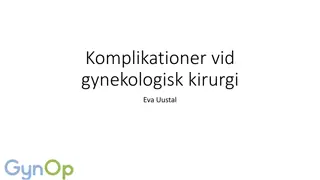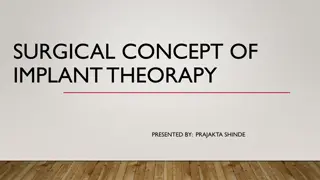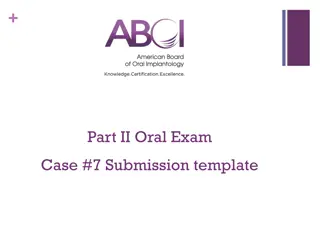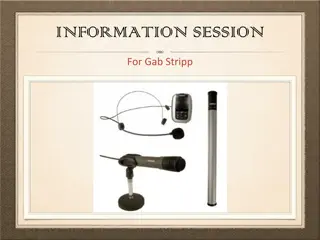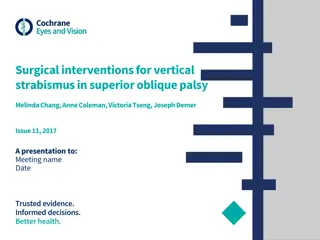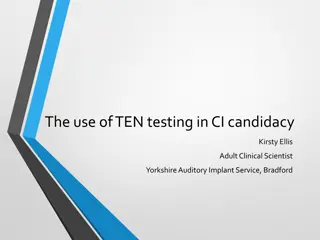Surgical and Functional Outcomes of Cochlear Implant in Chronic Otitis Media Patients
This study explores the surgical and audiologic outcomes of cochlear implantation in patients with chronic otitis media (COM) or chronic suppurative otitis media (CSOM). It discusses the challenges, surgical approaches, and follow-up assessments in patients undergoing cochlear implant surgery. The research aims to evaluate the efficacy and safety of cochlear implantation in individuals with COM or CSOM, shedding light on the feasibility and benefits of this intervention.
Download Presentation

Please find below an Image/Link to download the presentation.
The content on the website is provided AS IS for your information and personal use only. It may not be sold, licensed, or shared on other websites without obtaining consent from the author.If you encounter any issues during the download, it is possible that the publisher has removed the file from their server.
You are allowed to download the files provided on this website for personal or commercial use, subject to the condition that they are used lawfully. All files are the property of their respective owners.
The content on the website is provided AS IS for your information and personal use only. It may not be sold, licensed, or shared on other websites without obtaining consent from the author.
E N D
Presentation Transcript
Cochlear implant in patients with chronic otitis media: surgical and functional outcomes Murri A, Casulli M, Bartoli R, Auricchio D, Pantaleo A, Quaranta N
Background In the past chronic otitis media (COM) and chronic suppurative otitis media (CSOM) has been considered a contraindication to cochlear implantation due to possible problems associated with the insertion of a foreign body in the inner ear Cochlear implantation is possible; however, the ear must be dry and disease free at the time of implantation Various surgical options have been employed for CI in patients with CSOM. 1. The implant electrode can be inserted through the transcanal or middle fossa approach, bypassing the diseased middle ear and mastoid [Colletti et al., 1998; Kojima et al., 2010]. Elimination of inflammation can be achieved through tympanoplasty, tympanomastoidectomy, or subtotal petrosectomy, fol- lowed by CI. The implant electrode is then inserted into the inflammation-free cavity 3 6 months later (staged CI). Both elimination of inflammation and CI can be performed simultaneously (single stage CI). 2. 3.
Object To review audiological and surgical outcomes of COM-CSOM patients that underwent CI
Materials and Methods - Between 2018 and 2022, 18 patients with COM who underwent CI either in conjunction with (single stage CI) or following (staged CI) COM surgery were retrospectively analyzed. - Diagnosis of COM was made based on symptoms, otoscopic findings, and temporal bone computed tomography. - Patients with adhesive otitis media, atelectasis, CSOM with cholesteatoma, and previous open cavity surgery were included. - 6 patients with a follow-up period of <0.5 years were excluded from this study. COM Group - 12/18 pts - Mean age at CI surgery 62,3 yrs - Mean Follow-up 26,4 m - 6M:6F Control Group - 12 pts - Mean age at CI surgery 60,7 yrs - Mean Follow-up 36 m - 7M:5F
Audiological tests pre- CI and post-CI: - Pure tone Audiometry - FF pure tone audiometry - Speech in quiet - Speech in Noise (Italian Matrix Test) - Questionnaire - Chronic Otitis Media Questionnaire-12 (COMQ-12) - SSQ - THI - Cochlear implant Quality of life-35 profile
Age at CI Surger y Inflammatory status at time of surgery Chronic middle ea disorder Sex Previos sugery follow-up Side L R L R L Bil L R L R L R Subject f 1 77 COM active NA 36 m 2 80 CCOM stable CWD (4 surgeries) 36 m 3 57 CSOM stable CWD (4 surgeries) 22 m 4 73 COM stable radical cavity 18 f 5 69 CCOM active CWU (2 surgeries) 12 f 6 44 CSOM active CWU 24 f 7 38 COM stable CWU 52 f 8 63 COM stable CWU (2 surgeries) 24 m 9 76 COM stable CWU 36 m 10 33 CCOM stable CWD (2 surgeries) 36 f 11 74 COM stable CWU 16 m 12 64 CCOM stable NA 8
Surgical Results - COM and Control group received Nucleus CI (CI632-612) - No post operative complications - All COM group had subtotal petrosectomy with blind sac closure of EAC - Single-stage CI - 2 pts with obliteration of mastoid cavity with abdominal fat - 10 without mastoid cavity obliteration - No recidivism of COM- CSOM- CCOM (periodic CT-scan control)
Audiological Results Pre-CI pure tone audiometry PTA 250-4000 Hz 120 100 80 60 dB 40 20 0 PTA CI side PTA Controlateral side COM group Control Group
FF pure tone audiometry and Speech in quiet (65 dB) Last Follow-up * p<.05 n.s COM Group Control Group COM Group Control Group
Matrix test Last Follow-up n.s COM Control Group Group
COMQ-12 Questionnaire Last Follow-up Group Group COM Control P>.05
THI pre-post op COM Group Control Group
SSQ Questionnaire Last Follow-up 10 9 8 7 6 5 4 3 2 1 0 SSQ-S SSQ-SP Control Group SSQ-Q COM group P>.05
Cochlear Implant Quality of Life-35 Profile Instrument Scoring Manual The Cochlear Implant Quality of Life-35 Profile (CIQOL-35 Profile) is a patient-reported outcome measure that was developed to assess the functional ability of adult cochlear users in 6 domains:1-6 Communication: receptive and expressive communication ability in different situations Emotional: impact of hearing ability on emotional well-being Entertainment: enjoyment and clarity of TV, radio, and music Environmental: ability to distinguish and localize environmental sound Listening effort: degree of effort and resulting fatigue associated with listening Cochlear Implant Quality of Life-35 Profile Social: ability to interact in groups and to attend and enjoy social functions The CIQOL-10 Global measure is an additional patient-reported outcome measure that provides a general overall assessment of quality of life in CI users.4,6 The CIQOL-10 Global score can be derived from a subset of item-level responses from the CIQOL-35 Profile. . Participants should be instructed to answer all of the items in the instrument so a comprehensive measurement can be obtained. The CIQOL instruments were developed and validated for adult (ages 18+) cochlear implant users. Cochlear Implant Quality of Life-35 Profile Instrument Scoring Manual Scoring theCIQOL-35 Profile All items in the instrument utilize the same five answer choices. Individual items can be forward scored where 1=Never, 2=Rarely, 3= Sometimes, 4=Often, 5=Always or reversed scored where 5=Never, 4=Rarely, 3=Sometimes, 2=Often, 1=Always. The table below describes how each item in the CIQOL-35 Profile is assigned to a domain and whether the item should be forward or reversed scored. The Cochlear Implant Quality of Life-35 Profile (CIQOL-35 Profile) is a patient-reported outcome measure that was developed to assess the functional ability of adult cochlear users in 6 domains:1-6 Communication: receptive and expressive communication ability in different situations Emotional: impact of hearing ability on emotional well-being Entertainment: enjoyment and clarity of TV, radio, and music Environmental: ability to distinguish and localize environmental sound Listening effort: degree of effort and resulting fatigue associated with listening Social: ability to interact in groups and to attend and enjoy social functions Domain (item numbers) Forward Items Reversed Items Communication (1-10) Emotional (11-15) Entertainment (16-20) Environment (21-25) Listening Effort (26-30) Social (31-35) Global 1,2,3,4,5,7,8,9,10 6 11 17,18,19,20 21,22,23,24,25 26,27,28 31,32 1,5,9,11,17,25,26 14,30,33 12,13,14,15 16 29,30 33,34,35 The CIQOL-10 Global measure is an additional patient-reported outcome measure that provides a general overall assessment of quality of life in CI users.4,6 The CIQOL-10 Global score can be derived from a subset of item-level responses from the CIQOL-35 Profile. . Participants should be instructed to answer all of the items in the instrument so a comprehensive measurement can be obtained. The CIQOL instruments were developed and validated for adult (ages 18+) cochlear implant users. To calculate the scores for each domain and the Global measure, sum the individual item scores to obtain the raw score. Then use the table below to convert the raw score to the interval-scale score ( outcome measure ) as derived from item-response theory.5,6 Each outcome measure score has a standard error (SE) term, which is a statistical measure of variance. The 95% confidence interval around the outcome measure can be calculated from the SE: 95%CI= (1.96*SE). For example, a communication Scoring theCIQOL-35 Profile All items in the instrument utilize the same five answer choices. Individual items can be forward scored where 1=Never, 2=Rarely, 3= Sometimes, 4=Often, 5=Always or reversed scored where 5=Never, 4=Rarely, 3=Sometimes, 2=Often, 1=Always. The table below describes how each item in the CIQOL-35 Profile is assigned to a domain and whether the item should be forward or reversed scored. To calculate the scores for each domain and the Global measure, sum the individual item scores to obtain the raw score. Then use the table below to convert the raw score to the interval-scale score ( outcome measure ) as derived from item-response theory.5,6 Each outcome measure score has a standard error (SE) term, which is a statistical measure of variance. The 95% confidence interval around the outcome measure can be calculated from the SE: 95%CI= (1.96*SE). For example, a communication
Cochlear Implant Quality of Life-35 Profile 100 100 90 90 80 80 70 70 60 60 50 50 40 40 30 30 20 20 10 10 0 CIQOL-35 COMMUNICATION CONVERTED S. CIQOL-35 EMOTIONAL CONV.S. CIQOL-35 ENTERTAINMENT CONV.S. CIQOL-35 ENVIRONMENT CONVERT.S 0 CIQOL-35 LISTENING EFFORT CONVERT.S. CIQOL-35 SOCIAL CONVERT S. CIQOL-35 GLOBAL CONVERT. S. COM Group Control Group COM Group Control Group P>.05
Conclusions CI is challenging in patients with COM because elimination of inflammation and protection of the implant electrode array should be accomplished together. Subtotal petrosectomy and blind closure of EAC with or without middle ear obliteration may be the best option for long-term safety in patients with COM-CCOM-CSOM. All our 12 patients showed audiological benefits from their CI procedures like Control Group. These patients did not exhibit any complications, but we must consider the small number. Thank you !!!
